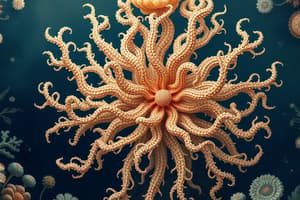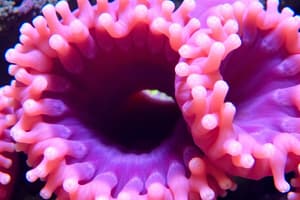Podcast
Questions and Answers
What typical animal features do sponges lack?
What typical animal features do sponges lack?
- Reproductive structures
- Circulatory system
- Digestive organs
- Muscle tissue and nervous system (correct)
What is demonstrated by the fluorescent dye in a sponge's canals?
What is demonstrated by the fluorescent dye in a sponge's canals?
- The sponge's ability to filter large particles
- The flow of water through the sponge (correct)
- The types of cells present in sponges
- The thickness of the sponge walls
What occurs when a small particle encounters a flagellated choanocyte in a sponge?
What occurs when a small particle encounters a flagellated choanocyte in a sponge?
- The choanocyte immobilizes the particle with toxins
- The choanocyte surrounds and ingests the particle (correct)
- The particle gets trapped and becomes food
- The particle is expelled without interaction
What strategy do cnidarians use to capture their prey?
What strategy do cnidarians use to capture their prey?
Which two classic forms of cnidarians does Preya bring together?
Which two classic forms of cnidarians does Preya bring together?
What occurs when a sponge is broken apart with a sieve?
What occurs when a sponge is broken apart with a sieve?
What is a key behavioral response of jellyfish when they sense a predator?
What is a key behavioral response of jellyfish when they sense a predator?
What does Stomphia do when it is attacked by a sea star?
What does Stomphia do when it is attacked by a sea star?
What type of interaction occurs during the battle between two anemones?
What type of interaction occurs during the battle between two anemones?
What do collar cells, or choanocytes, specifically help with in sponges?
What do collar cells, or choanocytes, specifically help with in sponges?
Flashcards are hidden until you start studying
Study Notes
Sponges: Origins
- Sponges are the most primitive animals.
- They lack distinct tissues, organs and a nervous system.
- Sponges can regenerate from fragments.
- They are filter feeders.
- Choanocytes (collar cells) pump water through the sponge using flagella.
- Flagella in the choanocytes capture food.
- Choanocytes line inner chambers.
- The fluorescent dye in the video highlights the water flow through the sponge's canals.
Cnidarians: Life on the Move
- Cnidarians are predatory animals with stinging cells.
- Cnidarians contain specialized cells called cnidocytes, which are used to paralyze their prey.
- Cnidocytes contain nematocysts, a capsule with a coiled thread that can be ejected.
- One anemone uses tentacles to fight off a rival.
- Stomphia detach itself from the sea bed to escape a predator.
- Preya represents two classic cnidarian forms: polyps and medusa.
- Some jellyfish use a bell to propel themselves away from danger.
Sponges: Origins
- Sponges lack:
- Tissues
- Organs
- Nervous system
- If you break a sponge apart with a sieve, each piece will regenerate into a new sponge.
- Fluorescent dye demonstrates the movement of water through the sponge canals.
- Collar cells (choanocytes) look like tiny cells with a collar and a flagellum.
- When a particle runs into a collar cell, the flagellum whips around, creating a current that pulls the particle into the cell for digestion.
Cnidarians: Life on the Move
- Cnidarians use stinging cells (nematocysts) to paralyze or capture their prey.
- The battle between two anemones involves them stinging and fighting each other for territory.
- When attacked by a sea star, Stomphia detaches itself from the ground and swims away.
- The two classic forms brought together in Preya are polyps (stationary, like anemones) and medusas (free-swimming, like jellyfish).
- When startled by a predator, a jellyfish can pulse its bell and swim quickly away.
Studying That Suits You
Use AI to generate personalized quizzes and flashcards to suit your learning preferences.




